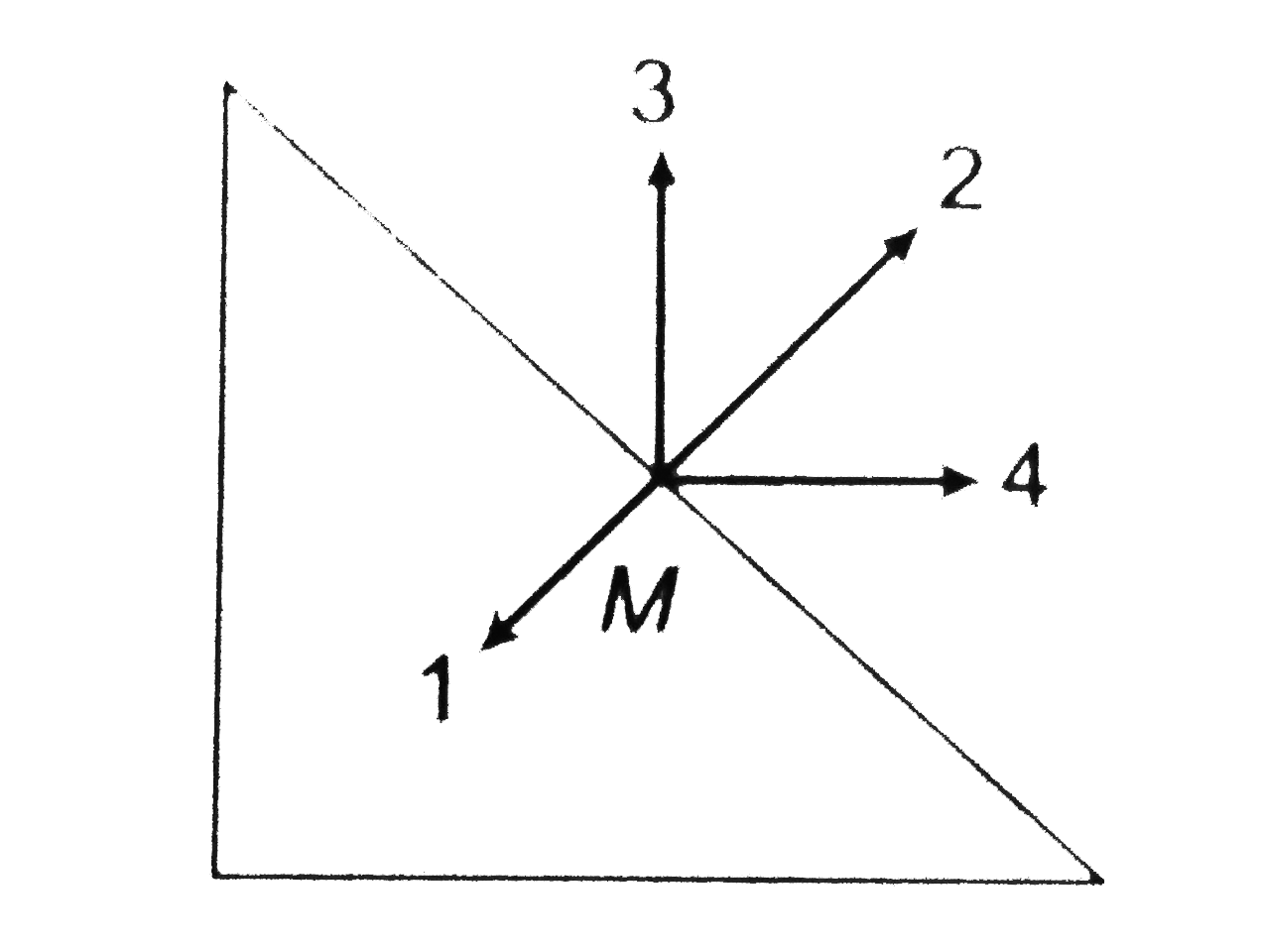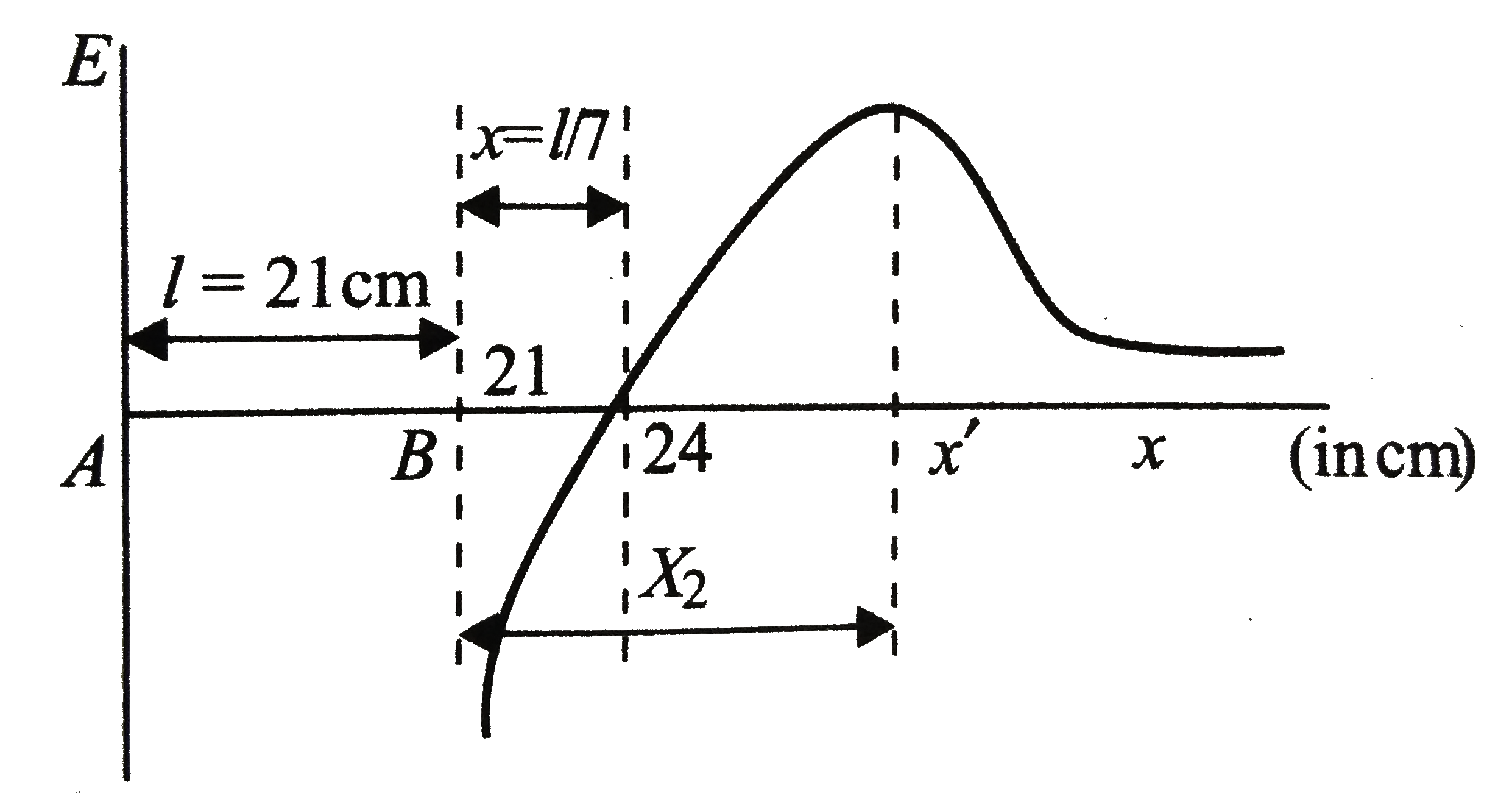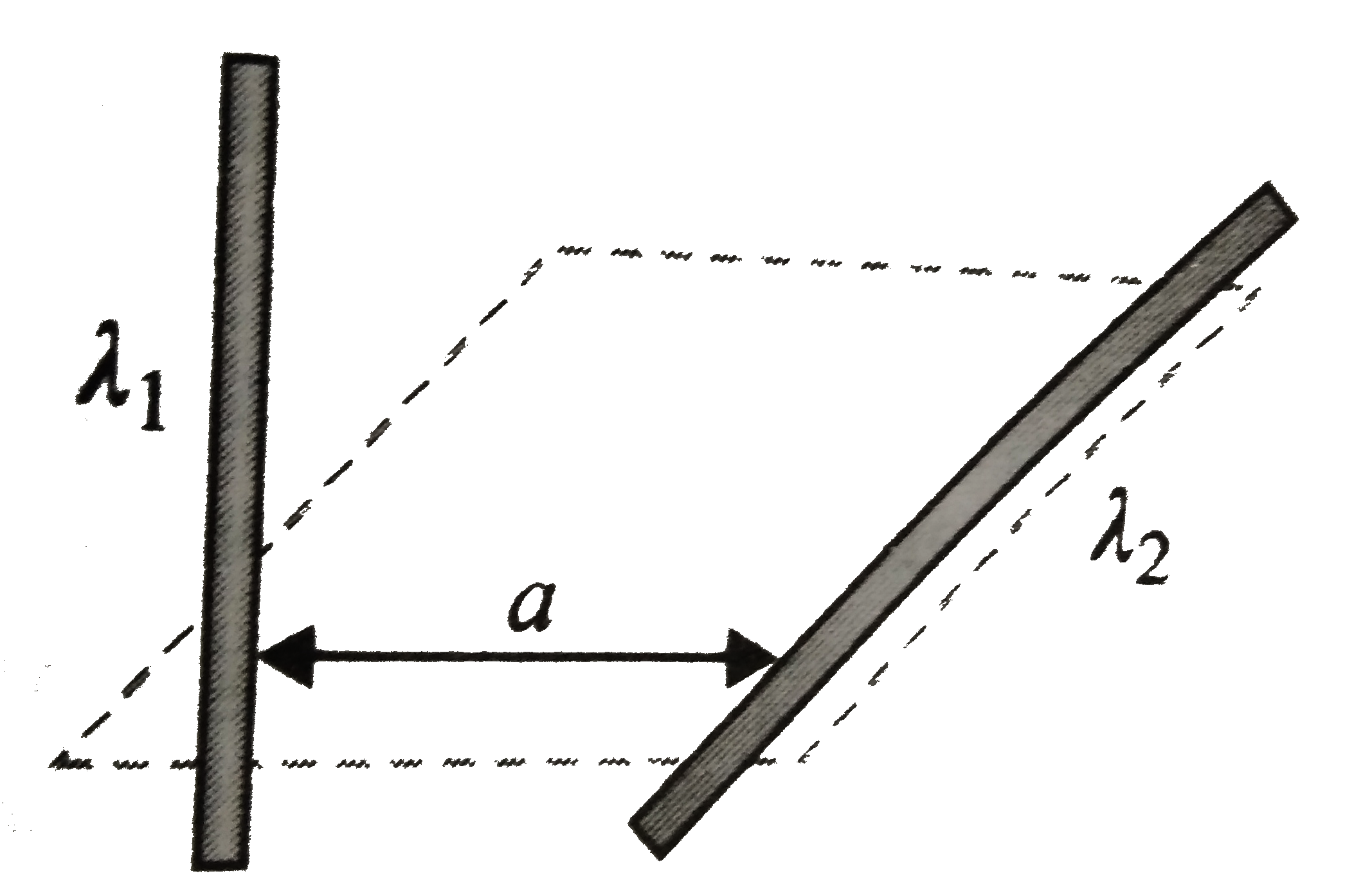Complete Solutions to All Questions of chapter ELECTROSTATICS of Class 12 book with complete answers and questions
| Class 12 | PHYSICS |
| Chapter | ELECTROSTATICS |
| LA SENA | All Questions |
| Number Of Questions | 42 |
| Academic Year | 2023-24 |
Three identical points charges, as shown are placed at the vertices of an isosceles right angled triangle. Which of the nembered vectors coincides in direction with the electric field at the mid-point `M` the hypotenuse
 01:25View Solution
01:25View SolutionTwo point-like charges a and b whose strengths are equal in absolute value are positioned at a certain distance from each other. Assuming the field strength is positive in the direction coinciding with the positive direction of the r axis, determine the signs of the charges for each distribution of the field strength between the charges shown in Figures `(a), (b), (c), and (d).`
02:38View SolutionTwo point charge `Q_(a)` and `Q_(b)` are positional at point A and B. The field strength to the right of charge `Q_(b)` on the line that passes through the two charges varies according to a law represented schematically in fig. (without employing a definite scale). The field strength is assumed to be positive if its direction coincides with the positive direction of the x-axis. The distance between the charges is `l=21 cm`.

(a) Find the sign of the charges.
(b) Find the ration between the absolute value of charge `Q_(a)` and `Q_(b)`.
(c ) Find the coordinate x of the point where the field strength is maximum.08:47View SolutionAn infinitely long straight conductor carrying a charge with a linear density `+T` and a point charge `-Q ` are at a certain distance from each other. In which of the three regions (I, II or III) are there points that (a) lie on the line passing through tho point charge perpendicular to the conductor. and (b) at which ..th~ field strength is zero 1)
04:51View SolutionTwo mutually perpendicular long straight conductors carrying uniformly distributed charges of linear charges densities `lambda_(1)` and `lambda_(2)` are position at a distance a from each other. How does the interaction between the rods depends on a ?
 05:49View Solution
05:49View SolutionNear an infinitely large flat plate with a surface charge density o on each side, the field strength is** `E=delta/(in n^delta),` while the field produced by a point charge at a distance r frorn the chargo is Prove that for a uniformly charged disk with a surface charge density a (on each side), the electric field strength on the axis of the disk is the same as for an infinitely large flat plate if the distances arc small in comparison with the disk's radius R, and is the same as for a point charge if the distances are large ** Usually the value of the field strength given in textbooks is half the one given here, since there it is assumed that the charge is on a geometric plane
09:27View SolutionAt a certain distance r l'rorn an infinitely long straight conductor with a unlforml y distributed l i nnar charge 't there is a dipolo with an electric moment Pel directed along the Ii no of Iorce represeul.ing the field generated by the conductor at the point where the dipole is located. Assuming the arm of the dipole is very small compared to the distance r, Iind the Iorce with which the field acts on the dipole.
02:18View SolutionThe figure shows the schematic of an absolute electrometer. The potential difference that is to be measured is applied between the plates `1 and 2`, with the upper plate connected to one arm of a balance beam.* The pan connected to the other arm is loaded with weights until balance is achieved, that is, when the upper plate begins to move upward. In this way the force acting between the charged plates is measured, and this enables one to determine the magnitude of the potential di fference between the plates. It the aquiltbrium in the electrometer stable or unstable? • The figure does not show the protecting rings around plates 1 and 2 with the same potentials. Theso are used to ensure that the field is as uniform as possible
03:04View SolutionA small thin metal strip lies on the lower plate of a parallel-plate capacitor positioned horizontally. The voltage across the capacitor plates is increased gradually to a value at which the electric force acting on the strip becomes greater than the strip's weight and makes the strip move toward the upper plate. Does the force acting on the strip remain coust.anj during the lifting process?
04:00View SolutionInto the region of space between the plates of a parallel-plate capacitor there Ilies (a) an electron and (b) a negatively charged ion with a velocity directed parallel to the plates. Both the electron and the ion have rec.eived their initial kinetic energy by passing the same potential difference `U_0` and the potental difference across the capacitor is U. The distance between the plates is d. Which of the two particles will travel a greater distance before hitting the positively charged plate if both fly into the capacitor at a point that is exactly in the middle of the distance between the plates?
05:07View SolutionAn electric dipole is positioned between a pointlike charge and a uniformly charged conducting plate. III which direction will the dipole move?
01:44View SolutionA point-like charge Q and a dipole with an electric moment Pel are separated by a distance that is considerably larger than the arm of the dipole, with the result that the dipole may be considered as being point. The dipole's axis lies :'along the lines of force 'of the point charge. Compare the force acting on the di pole ill the field of the point charge with t.hat acting on the point charge ill the Held of the di pole.
02:55View SolutionA small uncharged sphere is positioned exactly in the midpoint between two charges whose absolute values are the same but whose signs are opposite. Suppose the sphere is shifted sornewhat. Will it remain in the new position or will it move in some direction?
01:45View SolutionA. small uncharged metal sphere is suspended hy a long nonconducting string in the region between the vertically positioned plates of a parallel-plate capacitor, closer to one plate than to the other. How will the sphere behave?
02:16View SolutionTwo conducting spheres carry equal charges. the distance between the spheres cannot be considered large in comparison with the diameters of the spheres. In which case will the force of interaction between the spheres be greater (in absolute value): when they carry like charges (Figure (a)) or when they carry unlike charges (Figure (b))?
02:13View SolutionA point charge is surrounded by two spherical layers (Figure (a)), with the electric field st.rengt.h as a function of distance having the form depicted in Figure (b) (on the log-log scale). In what layer (the inner or the outer) is the dielectric constant greater and by what factor?
03:07View SolutionThe region of space between the plates of a parallel-plate capacitor is filled with a liquid dielectric with a dielectric constan `in_1`. • A solid dielectric wi th a dielectric. constant `in_2` is immersed in the liquid. The lines of force in t.he liquid have the shape shown in the figure. Which of the two dielectric constants is greater?
01:21View SolutionVarious potential distrihutions between two .point charges are shown in Figures `(a)-(d)` (the charges are equal in absolute value). Determine the signs of the charges for each case.
03:13View SolutionTwo point charges, `Q_1 and Q_2` are positioned at a certain distance from each other. Tho curves in the figure represent the distri bution of the potential along the straight line connecting the two charges. At which points `(1, 2, and /or 3)` is the electric field strength zero? What are tho signes of the charges `Q_1 and Q_2` and which of the two is greater in magnitude?
02:16View SolutionTwo equal like charges are positioned at a certain distance from each other. How do the electric field strength and the potential vary along the axis that passes through the midpoint of the distance between the charges at right angles to the line connecting the charges?
04:19View SolutionA potential difference is applied between a conducting sphere and a conducting plate C'plus" on the sphere and "minus" on the plate). The dimensions of the plate are much larger than the distance between sphere and plate. A, point positive charge. is moved from P?int 1 to point 2 parallel to the plate. Is any work dono In the process?
01:56View SolutionTwo parallel-plate capacitors with different distances between the plates are connected in parallel to a voltago source. A poin t posit.ivo charge is moved from a point 1 that is ex aetly j n the midtlle between the plates of a capacitor `Cl` to a point `2` (or a capacitor `C2`) that lies at a distance from the negative plate of `C2` equal to half the distance between the plates of `Cl.` Is any work done in the process?
02:38View SolutionThe space between the rectangular plates (with sides `a and b`) of a parallel-plato capacitor (the distance between the plates is l) is filled with a solid dielectric whose dielectric constant is c. The capacitor is charged to a certain potential difference and disconnected from the voltage source. After that the dielectric is slowly moved out of the capacitor, which lTIOanS that the section x not filled with the dielectric gradually increases in size. How wi ll the potential difference between the plates and the surface charge densities on both parts of the capacitor (with and without the dielectric) change in the process?
04:50View SolutionAt which of the two points, `1` or `2`, of a charged capacitor with nonparallel plates is the surface charge density greater?
01:48View SolutionThe diameter of the outer conductor of a cylindrical capacitor is `D_2` • What should the diameter of the core, `D_1` , of this capacitor be so that for a given potential difference between the outer conductor and the core the electric field strength at the core is minimal ?
02:13View SolutionFour capacitors, `C1, C2, C3, and C4`, are connected as shown in the figure. A potential di fference is applied between points `A and B.` What should the relationship between the capacitances of the capacitors be so that the potential difference between points `a and b` is zero?
01:52View SolutionAn electric charge with a constant volume density p is distributed within a solid sphere of radius R. Determine and represent graphically the radial distributions of tho electric Held strength and tho potential inside and outside the sphere.
08:33View SolutionIn the region of space between the plates of a parallel-plate capacitor there is a uniforrnly distributed positive charge with a volurne density p. The plates are connected electrically and their potential is set at zero. Calculate and draw a sketch of the distributions of the potential and electric field strength between the plates.
05:55View SolutionTwo series-connected capacitors of the sarne size, one filled with air and the other with a dielectric, are connected to a voltage source. To which of the capacitors a higher voltage is applied?
01:26View SolutionTwo identical air capacitors are connected in series. How will the charge on and potential difference across each capacitor change when the distance between the plates of one capacitor is increased in the following cases: when the capacitors are connected to a `DC` source, and when the capacitors are first charged and then disconnected from the `DC` source?
02:35View SolutionTwo identical parallel-plate air capacitors are connected in one case in parallel and in the other in series. In each case the plates of one capacitor are brought closer together by a distance a and the plates of the other are moved apart by the same distance a. How will the total capacitance of each system change as a result of such manipulations ?
03:12View SolutionA parallel-plate capacitor is filled with a dielectric up to one-half of the distance between the plates.The manner in which the potential between the plates varies is illustrated in the figure. Which half `(1 or 2)` of the space between the plates is filled with the dielectric and what will be the distribution of the potential after the dielectric is taken out of the capacitor provided that (a) the charges on the plates are conserved or (b) the potential difference across the capacitor is conserved?
03:03View SolutionA capacitor is partially filled with a dielectric. In which of its parts is the electric field strength greater? What about the electric displacement and the energy density?
01:48View SolutionTwo parallel-plate capacitors, one filled with air and the other with a dielectric, have the same geometric dimensions, are connected in parallel, and are charged to a certain potential difference. In which of the two capacitors is the electric field strength greater, in which is the electric displacement greater, in which is the energy density greater, and in which is the surface charge density on the plates greater?
02:26View SolutionThree point-like charges are positioned at the vertices of an equilateral triangles. Two are equal in magnitude and are like, while the third is opposite in sign. What should the magnitude of the third charge be so that the total interaction energy of the charges is zero?
01:53View SolutionThe dielectric filling the space between the plates of a capacitor that has been charged and then disconnected from the voltage source is removed. How should the distance between the plates be changed so that the energy stored in the capacitor remains the same? Explain the origin of the change in energy.
03:17View SolutionA capacitor between whose plates there is a dielectric with a dielectric constant e is connected to a DC source. How will the energy stored in the capacitor change if the dielectric is removed? Explain the cause of this change.
02:36View SolutionA parallel-plate capacitor that has been first charged and then disconnected from the voltage source is submerged in the vertical position into a liquid dielectric. How does the level of the dielectric. between the plates change in the process?
02:32View SolutionA parallel-plate capacitor with vertical plates is connected to a voltage source and then submerged into a liquid dielectric. How does the level of the dielectric between the plates change in the process? Explain the change of the energy stored by the capacitor
01:32View SolutionA cube has been cut out from a piezoelectric crystal. When the cube was compressed, it exhibited electric charges on the faces: a positive charge on the upper face and a negative charge on the lower (Figure `(a)`). When the cube was stretched, the charges were found to change their signs (Figure `(b)`). What will be the signs of the charges on these faces if pressure is applied as shown in Figura `(c)` ?
01:14View SolutionThe relationship that exists between the electric displacement and the electric field strength in a ferroeleetric is given by the curve of primary polarization and a hysteresis loop. Are there any points on the hysteresis loop to which we might formally assign a dielectric constant equal to zero or to infinity?
01:30View SolutionA charged parallel-plate capacitor is moving with respect to a certain system of coordinates with a velocity v directed parallel to the plates. What is the ratio of tho electric field between the plates in this coordinate system to the same quantity in the system of coordinates in which the capacitor is at rest ?
01:55View Solution
All Questions questions and complete solutions for chapter ELECTROSTATICS of IE IRODOV PHYSICS (HINGLISH) of Class 12
